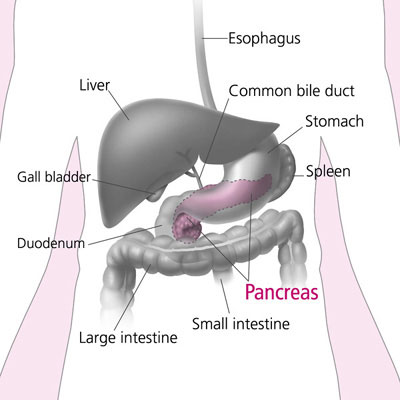pancreas

Dissection of the pancreas showing the pancreatic duct leading into the duodenum. The section at the top right shows an islet of Langerhans.

Pancreas and nearby organs.

Pancreas, common bile duct, and small intestine.
The pancreas is a long, soft organ that lies transversely along the back of the abdominal wall, behind the stomach, and extends from the region of the duodenum to the spleen. In an adult the pancreas is about 15 cm (6 in long) and weighs about 115 grams (4 ounces).
The pancreas functions as both an exocrine gland and an endocrine gland. The exocrine portion secretes digestive enzymes that are carried through a duct to the duodenum (the first part of the small intestine). The endocrine portion, known as the islets of Langerhans, secretes four different hormones into the blood stream to help the body regulate sugar metabolism.
In mammals, the pancreas contains three classes of cell types: the ductal cells, the acinar cells, and the endocrine cells. The endocrine cells, or islet cells, produce the hormones glucagon, somatostatin, pancreatic polypeptide (PP), and insulin. The acinar cells are part of the exocrine system, which manufactures digestive enzymes, and ductal cells from the pancreatic ducts, which connect the acinar cells to digestive organs.
In humans, the pancreas develops as an outgrowth of the duodenum. The cells of both the exocrine system – the acinar cells – and of the endocrine system – the islet cells – seem to originate from the ductal cells during development. During development these endocrine cells emerge from the pancreatic ducts and form aggregates that eventually form the islets of Langerhans.
In humans, there are four types of islet cells: the insulin-producing beta cells; the alpha cells, which produce glucagon; the delta cells, which secrete somatostatin; and the PP-cells, which produce pancreatic polypeptide. The hormones released from each type of islet cell have a role in regulating hormones released from other islet cells. In the human pancreas, 65 to 90% of islet cells are beta cells, 15 to 20% are alpha-cells, 3 to 10% are delta cells, and one percent is PP cells.
Acinar cells form small lobules contiguous with the ducts. The resulting pancreas is a combination of a lobulated, branched acinar gland that forms the exocrine pancreas, and, embedded in the acinar gland, the islets of Langerhans, which constitute the endocrine pancreas.
Alpha cells in the pancreatic islets secrete the hormone glucagon in response to a low concentration of glucose in the blood. Beta cells in the pancreatic islets secrete the hormone insulin in response to a high concentration of glucose in the blood.


